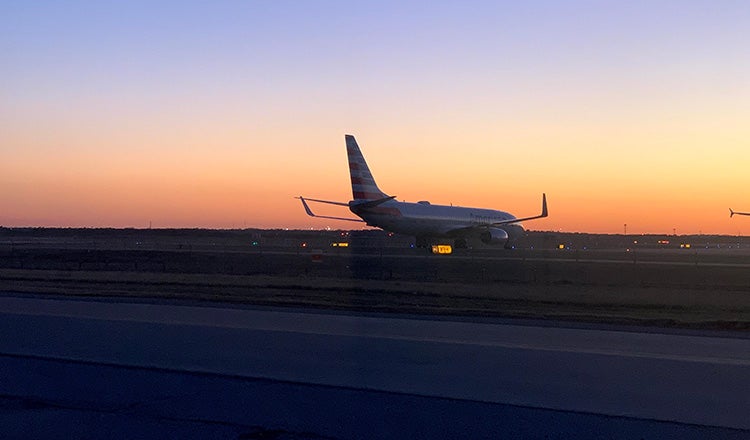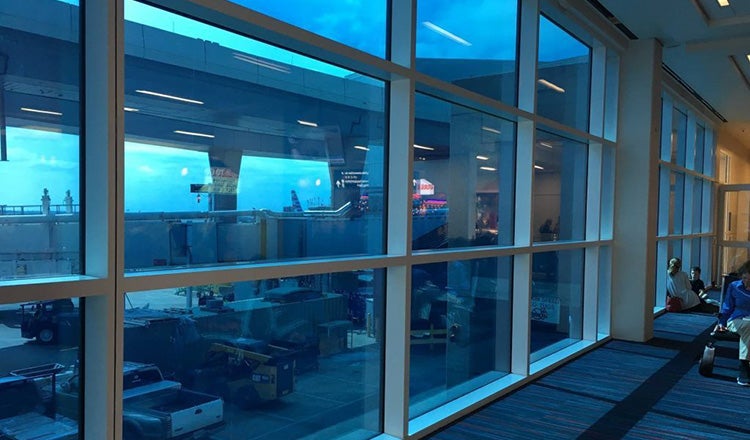
Experts Talk: Creating a Vision for Sustainable, Future-Ready Airports with Esther Chitsinde
Experts Talk is an interview series with technical leaders from across our transportation program.
How Airports Can Initiate Ambitious Sustainability Goals and Enhance Their Sustainability Commitments
Airports across the globe are looking for ways to use rapidly evolving technologies to improve their sustainability. Leaders of growing facilities hope to enhance their economic and social benefits while at the same time reducing harm to the environment and the community. How can airports navigate this complexity and become truly sustainable? By developing a vision prioritizing sustainability, customer experience and innovation.

Esther Chitsinde is an environmental scientist and planner with a deep understanding of airport sustainability and environmental issues. Chitsinde specializes in goal-setting in her projects and initiatives, helping clients tackle complex problems, develop legally defensible environmental documents, and streamline processes to meet strict federal funding deadlines. Before joining HDR, Chitsinde led Dallas Fort Worth International Airport’s NEPA and Special Projects program, which the Federal Aviation Agency recognized as the industry standard when FAA presented DFW with the Environmental Achievement Award during the 2019 FAA Southwest Region Award Ceremony. Her broad expertise gives her insight into all the components of airport sustainability and the National Environmental Policy Act process, from planning to project delivery. In this interview, she explains the importance of sustainability, shares how airports can successfully set and pursue their sustainability goals, and describes the investments needed to prepare airports for the future.
Q. Why should airports invest in sustainability?
A. In short, sustainability is good business. Moreover, innovative sustainable strategies employing effective problem-solving and driving profitability capture the complementary nature of these investments. For example, consider Dallas Fort Worth International Airport. DFW made an intentional decision to invest in dynamic glass, a sustainable solution designed to reduce the heat and glare entering the Terminal A building. This decision resulted in lower temperatures in the gate lounges and reduced the energy needed for air conditioning in the space. As such, the project reduced energy costs while maintaining a comfortable gate area for customers. DFW also found an unintended positive outcome: more people remained near the gate areas outfitted with the dynamic glass technology, and sales at concessionaires within the same gate area increased by more than 100% (month-over-month for more than one year). In other words, this sustainable decision created a win-win-win, resulting in reduced energy consumption, improved customer experience and improved business performance.
Investing in sustainability offers a variety of benefits:
- Mitigation of risk from potential disruptions
- Adherence to industry norms of transparency, disclosures and social responsibility
- Fulfillment of investor requirements
- Goodwill with key stakeholders and customers
- Diversification and enhancement of revenue sources
- Reduction of operating and maintenance costs
Sustainability reduces environmental impacts, reduces costs, enhances customer experience, helps maintain and enhance economic growth, and ensures organizational goals are achieved in ways that are consistent with the needs and values of the local community and the planet.
Q. Where should airports begin when it comes to sustainability?
A. Successful airport sustainability programs start with a vision and a commitment to sustainability by the airport executive leadership team. The most significant next step is comprehensively understanding the airport ecosystem and its stressors. In addition, there are four pillars of airport sustainability, as identified by the Airport Cooperative Research Program and Airport Council International-North America:
- Economic viability: How decisions will affect the airport’s finances and business performance
- Operational efficiency: How decisions will affect safe and efficient aircraft operations
- Natural resource conservation: How decisions affect the air, land and water on and around the airport
- Social responsibility: How decisions affect people — employees, customers, passengers, communities around airports and business partners
Airports pioneering sustainability should consider these four key areas as they develop and deliver unrivaled customer experience. Finally, cross-functional problem-solving should be prioritized to accelerate and amplify the return-on-investment proposition.

Q. How can airports apply their facility-wide sustainability goals to specific projects?
A. Organizations must first assess and evaluate existing conditions (within the airport ecosystem), then set goals and prioritize actions to operationalize sustainability principles.
These goals can and should be ambitious, but they also must include actionable metrics for success. Ambitious sustainability goals that are above and beyond IATA’s goal to achieve NetZero carbon by 2050 can include:
- Decarbonization: Reduce carbon dioxide emission and achieve NetZero carbon by 2030
- Energy Optimization: Reduce energy consumption by 50% by 2030
- Waste Reduction and Reuse: Recycle 90% of construction materials/waste and achieve zero waste by 2040
- Water Conservation: Reduce water use by 40% and use 100% reclaimed water for irrigation by 2030
To achieve ambitious sustainability goals, airport executive leaders must strongly commit to sustainability and serve as internal champions. Airports must also invest in technology and training, engage with internal and external stakeholders, and foster strong relationships with key strategic partners (internal and external), including airlines, technology developers, educational institutions and government agencies.
A successful sustainability program also includes reporting to celebrate successes, acknowledge challenges, mitigate risks and proactively align with future regulations. Therefore, reporting on sustainability commitments, accomplishments and performance metrics is imperative. One way to do that is through an Environmental and Social Governance report, a powerful tool based on a holistic framework that measures what is good for business, people and the planet. ESG reports are designed to demonstrate accountability to an organization’s public commitments and, as a result, can help airports gain credibility and enhance their reputation.
Q. What will it take for airports to implement their sustainability goals and be ready for the future?
A. As airports grapple with challenges from aging infrastructure to climate change, we will see more and more that resiliency is a business imperative for achieving a sustainable future. As we design projects lasting for decades, resiliency will be the key to operational and infrastructure success.
For an organization to be resilient and future-ready — and therefore increase long-term sustainability — consider strategic investments in these areas:
Digital twins: Airport decision-makers will need access to new, innovative approaches for day-to-day operations and long-term strategic planning decisions to enhance operations. Digital twins are rapidly transforming our ability to solve problems. Digital twins are virtual replicas of the physical world, including the operations and the transboundary flow of information within the airport system. They can integrate real-time and historical data and allow us to explore a wide range of “what-if” scenarios to test policies and interventions within a virtual environment before full-scale deployment.
Data driven solutions: To address the current and future challenges, airports should develop sustainable and resilient decision-making policies that leverage data-driven insights, cross-functional collaboration and adaptive learning.
In 2020, DFW doubled down on its indoor environmental quality investments and installed additional sensors to track real-time carbon dioxide and temperature data and then correlate the data to occupancy. For example, in August 2021, there were flight cancellations, and the sensors’ data showed spikes in carbon dioxide and temperature levels, which indicated that passengers were likely stationary/congregating and there was a need for increased HVAC airflow to those specific areas of the terminal to improve the indoor environment for customers. In addition, the airport team members use historical sensor data to recognize trends and make operational changes to improve building conditions and comfort.
Strategic partnerships: Building and fostering strong relationships with airline partners, government agencies, consultants, suppliers, and local businesses will close key information gaps, improve guidance, and provide access to skilled experts, thought leaders and innovative tools.
At DFW, a host of internal and external stakeholders came together to identify several seemingly disparate priorities: comfort within gate lounges, eliminating concession losses due to sun-damaged products and reducing energy consumption.
The solution: dynamic glass, which optimizes daylight and includes strategically located sensors that provide indoor environmental quality data to inform decision-makers. During the demonstration project, DFW learned that the dynamic glass’s automatic tinting reduced glare and heat loading (~15 degrees cooler), reduced HVAC demand, improved customer comfort (83% longer passenger dwell times), and increased concessionaire sales (102% increase in revenue). Given the incredible results and data-supported success of the project, DFW made the decision to invest in dynamic glass — a solution that helped many different stakeholders.

Courtesy Dallas Fort Worth International Airport
Q. How can airports fund these kinds of major investments?
A. There is currently an unprecedented level of federal funding for aviation and other transportation sustainability projects in the United States between the Bipartisan Infrastructure Law and the Inflation Reduction Act. In addition, this administration is increasing sustainability and environmental requirements. Now is the time to be ambitious in seeking out and investing in significant sustainability projects.
Demonstrating progress towards meeting sustainability commitments is integral to a grant application. It is emphasized in the recent infrastructure laws that direct agencies to use sustainability criteria and metrics to determine which projects get grant funding awards. Another important consideration when securing federal dollars is planning the project strategically so that the schedule aligns with the federal funding opportunities, requirements and statutory timelines for requisite approvals. It’s also essential to have partners that can streamline the NEPA process (providing quality and complete data) and seamlessly prepare top-notch NEPA documents to meet tight federal funding schedules for eligible projects.
This funding can potentially create generational change in airport sustainability, bringing real needle-moving projects to life. Your organization could be among them.

Inspiration & Advice
Q. How did you become interested in airport sustainability?
A. My parents are passionate about learning, a real-world application of knowledge, and the conservation of natural resources. As commercial farmers, my parents realized that the livelihood and survival of our communities depended on sustainable agricultural practices such as water conservation, crop rotations, sustainable grazing and education. At a young age, they taught me the need to balance our consumption of resources and their protection. So, during my undergraduate and graduate studies in environmental science, I was keen on finding ways to apply the lessons/knowledge; this led to me seeking out internship opportunities and getting the opportunity to serve as an intern within the Environmental Affairs Department at DFW International Airport. This internship helped me grow and understand the complexity of the airport ecosystem; it also kindled my passion for aviation and kickstarted my career in the aviation industry. Upon completion of my master’s degree, I was afforded the opportunity to work for DFW Airport, first as a member of the stormwater compliance team and then evolving into leading a successful, nationally recognized NEPA and Special Projects program for the airport and collaborating in high-level research and policy development for national priorities under the Department of Energy and its National Renewable Energy Laboratory.
Q. What advice do you have for someone just starting to work in the field?
A. Sustainability is new and rapidly evolving field. Be curious and be a life-long learner.
Each Experts Talk interview illuminates a different aspect of transportation infrastructure planning, design and delivery. Check back regularly for new insights from the specialized experts and thought leaders behind our award-winning, full service consulting practice.


